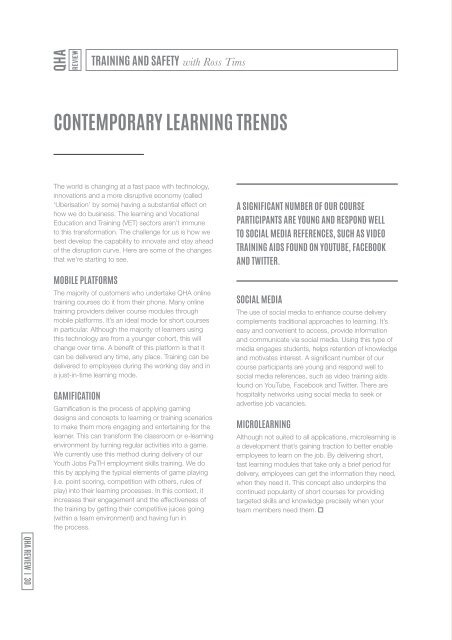QHA Review January 2018
You also want an ePaper? Increase the reach of your titles
YUMPU automatically turns print PDFs into web optimized ePapers that Google loves.
TRAINING AND SAFETY with Ross Tims<br />
CONTEMPORARY LEARNING TRENDS<br />
The world is changing at a fast pace with technology,<br />
innovations and a more disruptive economy (called<br />
‘Uberisation’ by some) having a substantial effect on<br />
how we do business. The learning and Vocational<br />
Education and Training (VET) sectors aren’t immune<br />
to this transformation. The challenge for us is how we<br />
best develop the capability to innovate and stay ahead<br />
of the disruption curve. Here are some of the changes<br />
that we’re starting to see.<br />
MOBILE PLATFORMS<br />
The majority of customers who undertake <strong>QHA</strong> online<br />
training courses do it from their phone. Many online<br />
training providers deliver course modules through<br />
mobile platforms. It’s an ideal mode for short courses<br />
in particular. Although the majority of learners using<br />
this technology are from a younger cohort, this will<br />
change over time. A benefit of this platform is that it<br />
can be delivered any time, any place. Training can be<br />
delivered to employees during the working day and in<br />
a just-in-time learning mode.<br />
GAMIFICATION<br />
Gamification is the process of applying gaming<br />
designs and concepts to learning or training scenarios<br />
to make them more engaging and entertaining for the<br />
learner. This can transform the classroom or e-learning<br />
environment by turning regular activities into a game.<br />
We currently use this method during delivery of our<br />
Youth Jobs PaTH employment skills training. We do<br />
this by applying the typical elements of game playing<br />
(i.e. point scoring, competition with others, rules of<br />
play) into their learning processes. In this context, it<br />
increases their engagement and the effectiveness of<br />
the training by getting their competitive juices going<br />
(within a team environment) and having fun in<br />
the process.<br />
A SIGNIFICANT NUMBER OF OUR COURSE<br />
PARTICIPANTS ARE YOUNG AND RESPOND WELL<br />
TO SOCIAL MEDIA REFERENCES, SUCH AS VIDEO<br />
TRAINING AIDS FOUND ON YOUTUBE, FACEBOOK<br />
AND TWITTER.<br />
SOCIAL MEDIA<br />
The use of social media to enhance course delivery<br />
complements traditional approaches to learning. It’s<br />
easy and convenient to access, provide information<br />
and communicate via social media. Using this type of<br />
media engages students, helps retention of knowledge<br />
and motivates interest. A significant number of our<br />
course participants are young and respond well to<br />
social media references, such as video training aids<br />
found on YouTube, Facebook and Twitter. There are<br />
hospitality networks using social media to seek or<br />
advertise job vacancies.<br />
MICROLEARNING<br />
Although not suited to all applications, microlearning is<br />
a development that’s gaining traction to better enable<br />
employees to learn on the job. By delivering short,<br />
fast learning modules that take only a brief period for<br />
delivery, employees can get the information they need,<br />
when they need it. This concept also underpins the<br />
continued popularity of short courses for providing<br />
targeted skills and knowledge precisely when your<br />
team members need them.<br />
<strong>QHA</strong> REVIEW | 30

















